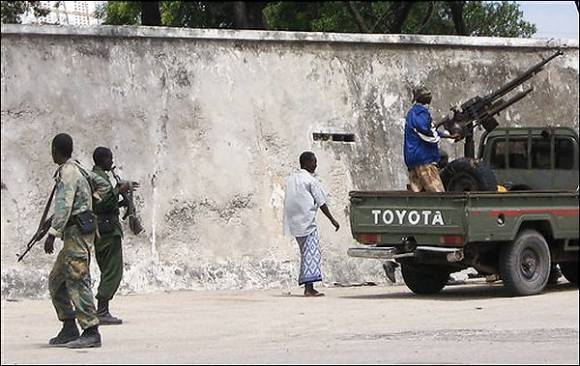Source: Business Daily 09/01/2012

Laban Walloga | Nation A Kenya Army jeep at the Ishakani border point in Kiunga as it heads for the battlefront in Somalia on October 27, 2011.The African Union has approved the integration of Kenyan troops into its mission in Somalia, easing the financial burden of cushioning the country from the threat of Al-Shabaab militia.
The African Union has approved the integration of Kenyan troops into its mission in Somalia, easing the financial burden of cushioning the country from the threat of Al-Shabaab militia.
The decision reached in Addis Ababa last week by AU’s Peace and Security Council means that the Kenya Defence Force (KDF) soldiers in Somalia will operate under the African Union Mission in Somalia (Amisom), receiving financial and logistics support from the United Nations.
“The council endorses the strategic concept for future operations … including the increase of the level of UN-supported Amisom uniformed personnel from 12,000 to 17,731, including 5,700 from the Djiboutian contingent and the re-hatted Kenyan troops, as well as Amisom’s police component,” reads part of a communiqué issued following last week’s meeting of the council.
Kenya whose troops crossed the border two months ago to hunt Al-Qaeda-linked terror group had last month approved the integration of its soldiers into Amisom, hoping to reduce the financial burden of an open ended warfare.
The cost of keeping one soldier in Somalia battlefield is estimated at around Sh7,000 per day (or Sh200,000 a month), covering transport, food and water expenses, communication and medical care.
This translates to Sh1 billion for keeping 1,000 soldiers in the battlefield for six months which would have caused a big dent in the national budget.
Drought at home and high global commodity prices had already forced Treasury to waive taxes on essential items, weakening the government’s ability to finance an open-ended war in Somalia.
Besides, Kenya is grappling with a budget deficit of Sh236 billion of the 1.2 trillion plan that Finance minister Uhuru Kenyatta unveiled in June last year.
Self-sponsored war would have forced ministries to cut development spending as the government diverted cash Somalia mission
At its last week’s meeting, the AU’s Peace and Security Council also renewed the mandate of Amisom for a further period of 12 months with effect from January 16.
This and the decision to raise the number of troops represent a major boost for Amisom, which has had to do with about 10,000 personnel — less than the 12,000 approved in 2007 by UN.
In the coming days, UN will meet to review and approve AU’s request for more troops and logistics support, the council said.
In a thinly veiled threat to neighbouring states and organisations that maintain networks with Al-Shabaab, AU said it would take all necessary measures against spoilers, both internal and external, undermining peace and reconciliation in Somalia, as well as the efforts of Amisom.
The communiques followed six East Africa nations’ defence officials endorsement of new military strategy for Somalia. The 15-member states Peace and Security Council also approved the “strategic” withdrawal of Ethiopian troops from Somalia.
Ethiopia, which had denied involvement in Somalia admitted last week that its troops controlled the central Somalia town of Beledwey’e.
By GEORGE OMONDI and ARGAW ASHINE












